Water Test: Field vs Lab – Discover everything you need to know about water used in construction as per Indian Standards. This guide explores water testing in the field vs lab, permissible impurity limits, and IS codes like IS 456:2000 for better construction quality.
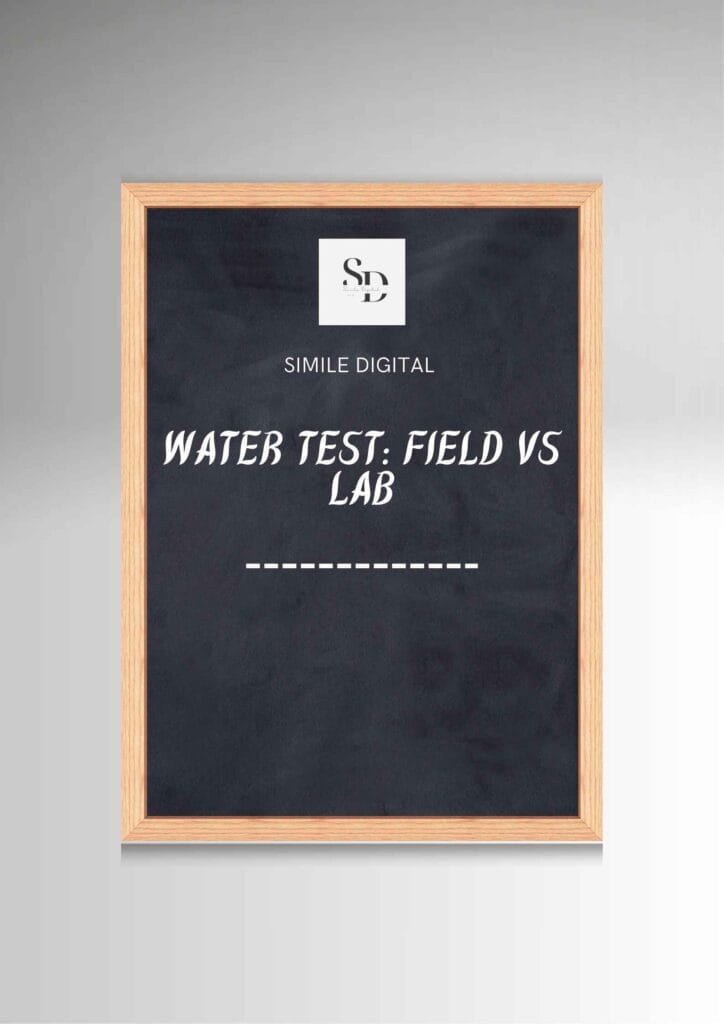
Table of Contents
Introduction
In the world of construction, water often takes a backseat to materials like cement, sand, and steel. Yet, this humble component plays a vital role in defining the strength, durability, and overall quality of a structure. Whether it’s used for mixing concrete, curing, or cleaning, the quality of water can directly impact the performance of the entire construction project.
Contrary to popular belief, not all water is suitable for construction. Just because water looks clear or tastes fine doesn’t mean it meets the criteria set by Indian Standards. Water can carry invisible threats—like chlorides, sulphates, or organic impurities—that may not only weaken the concrete but also corrode the reinforcement bars over time. This is why BIS (Bureau of Indian Standards) has laid down specific guidelines in codes such as IS 456:2000 and IS 3025 to ensure that only the right kind of water goes into construction work.
To verify water quality, two primary approaches are followed: field testing and laboratory testing. Field tests are quick, often done on-site, and help give an immediate idea of visible or surface-level impurities. On the other hand, lab tests are detailed, scientific, and help evaluate the chemical and mineral composition of water with precision. Both have their own place in the quality control process.
In this article, we’ll dive deep into the comparison of field vs lab tests for construction water. We’ll explore why testing water is essential, what Indian Standards prescribe, and how you can ensure that the water you use doesn’t become the weak link in your project’s foundation.
Physical Properties of Water
1. Color: Pure water is colorless. For construction purposes, water should also appear clear to the eye. Any discoloration may indicate contamination or suspended impurities like clay, algae, or rust, which are undesirable in concrete mixing and curing.
2. Odor: Fresh and clean water is odorless. Any noticeable smell—like that of decaying matter, chemicals, or sewage—suggests organic or industrial pollution. Water with a foul odor should never be used in construction, as it may contain harmful substances.
3. Taste: Although taste is not relevant for construction, any salty or metallic taste in water may indicate high levels of dissolved salts or minerals, which could interfere with the hydration of cement.
4. Turbidity: Water turbidity refers to its cloudiness caused by suspended particles. Water used in construction should have low turbidity, meaning it should be clear and free of visible particles. High turbidity can affect the workability and strength of concrete.
5. Temperature: The temperature of water can affect the setting time of cement. Very cold water slows down the hydration process, while very hot water can lead to flash setting. Ideally, water should be at ambient temperature, typically between 20°C to 27°C.
6. Density: The density of pure water is 1000 kg/m³ at 4°C. This property is used in various calculations during mix design. While the density can vary slightly with temperature and dissolved substances, water used in concrete generally maintains this standard range.
7. Specific Gravity: Water has a specific gravity of 1.0 at 4°C. Specific gravity is the ratio of the density of water to the density of a reference substance (usually another liquid). In mix design and lab testing, specific gravity helps to determine the relative proportion of water to other ingredients.
8. Viscosity: Water has relatively low viscosity, meaning it flows easily. In construction, low viscosity helps it mix thoroughly with cement and aggregates, ensuring good hydration and bonding.
9. Boiling and Freezing Points: Water boils at 100°C and freezes at 0°C under normal atmospheric pressure. While this is basic science, it’s relevant in construction when working in extreme weather conditions, where freezing or evaporation of water can affect concrete strength and curing.
10. Surface Tension: Water has a high surface tension, which affects how it interacts with fine particles like cement. It helps water spread evenly across surfaces during mixing, though excessive surface tension can reduce penetration in very fine concrete mixes.
11. Compressibility: Water is considered nearly incompressible, which is important in understanding pressure-related properties of concrete when water is involved during mixing and compaction.
12. Solvent Nature: Water is a universal solvent. This means it can dissolve a wide range of minerals and salts. While this is a good property in general, it becomes a concern in construction if it dissolves harmful salts like chlorides or sulphates, which can cause corrosion or cracking.
13. Electrical Conductivity: Pure water has very low electrical conductivity, but when it contains salts and minerals, its conductivity increases. Measuring conductivity in water samples is a quick way to estimate Total Dissolved Solids (TDS), which is important in assessing water quality for concrete use.
Chemical Properties and Allowable Limits of Minerals in Water (As per Indian Standards)
- Water used in concrete must be chemically clean, as certain dissolved minerals and salts can have harmful effects on concrete strength and reinforcement corrosion. The Bureau of Indian Standards, especially IS 456:2000, has specified clear permissible limits.
- The acidity of water should be such that it does not require more than 5 ml of 0.02N sodium hydroxide solution to neutralize 100 ml of water. If it does, the water is considered too acidic for use.
- Similarly, for alkalinity, water should not require more than 25 ml of 0.02N sulfuric acid to neutralize 100 ml of the sample. Excessive alkalinity can disrupt the setting and bonding of cement.
- The most important harmful substances include chlorides and sulphates. For chloride content, the maximum allowable limit is 500 mg per litre for reinforced concrete and 2000 mg per litre for plain cement concrete. Chlorides above this level can lead to rusting of steel rebars and spalling of concrete.
- Sulphate content in water should not exceed 400 mg per litre, as sulphates cause expansion and cracking in concrete over time.
- Water should also be free from suspended solids and organic matter. Suspended solids must not exceed 2000 mg/l, while organic solids must be less than 200 mg/l. Inorganic solids can go up to 3000 mg/l. High levels of suspended particles reduce concrete strength and make curing ineffective.
- Although Total Dissolved Solids (TDS) are not directly limited in IS 456, it is generally accepted that water with TDS values higher than 5000 mg/l should not be used unless proven to be safe through proper testing.
Chemical Composition of Water (H₂O)
Water is a simple yet vital compound with the chemical formula H₂O. This means:
- H₂ stands for two hydrogen atoms
- O stands for one oxygen atom
- These three atoms are covalently bonded to form a single water molecule.
Structure of a Water Molecule:
- Water has a bent or V-shaped molecular geometry.
- The bond angle between the two hydrogen atoms is about 104.5 degrees.
- Oxygen is more electronegative, pulling the shared electrons towards itself, making water a polar molecule.
Molecular Weight of Water:
- Hydrogen (H) = 1.008 × 2 = 2.016 g/mol
- Oxygen (O) = 15.999 g/mol
- So, Molecular weight of H₂O = 18.015 g/mol
Key Chemical Properties:
- Polarity: Makes water an excellent solvent (often called the “universal solvent”).
- High Specific Heat: Can absorb a lot of heat before its temperature rises.
- Cohesion and Adhesion: Sticks to itself and to other surfaces.
- Neutral pH: Pure water has a pH of 7, meaning it’s neither acidic nor basic.
- Dissociation: Water can dissociate into H⁺ and OH⁻ ions (very slightly), which is essential in chemical and biological reactions.
Tests For Water
Field Tests for Water
- Visual Inspection Test
- Odor Test
- Taste Test
- pH Strip Test
- Soap Lather Test
- Turbidity Test
- TDS Meter Test
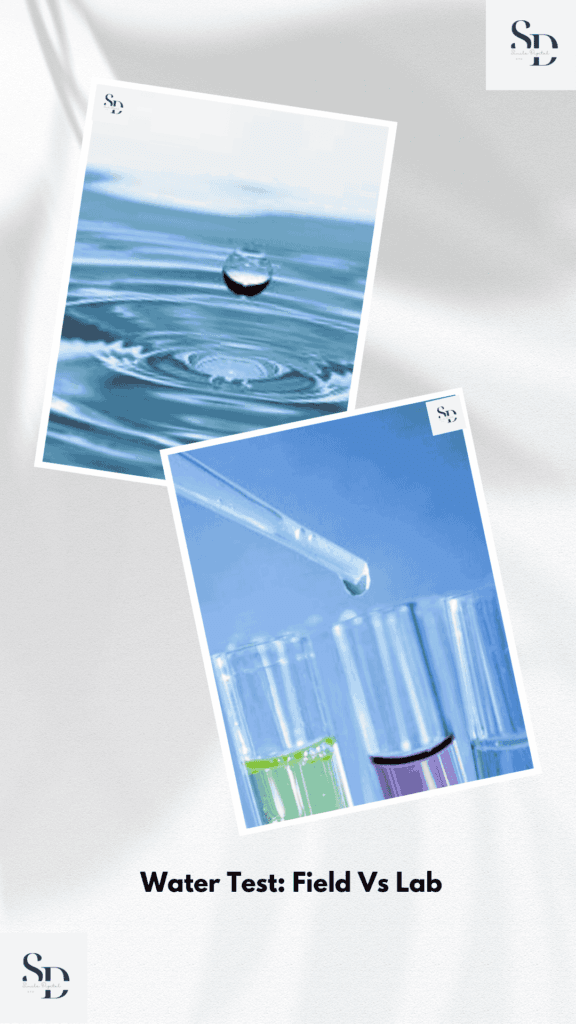
Laboratory Tests for Water
- pH Value
- Total Dissolved Solids (TDS)
- Chloride Content
- Sulphate Content
- Suspended Matter
- Alkalinity
- Acidity
- Organic Matter
- Hardness (as CaCO₃)
- Iron Content
- Manganese Content
- Turbidity
- Electrical Conductivity
Field Tests for Water
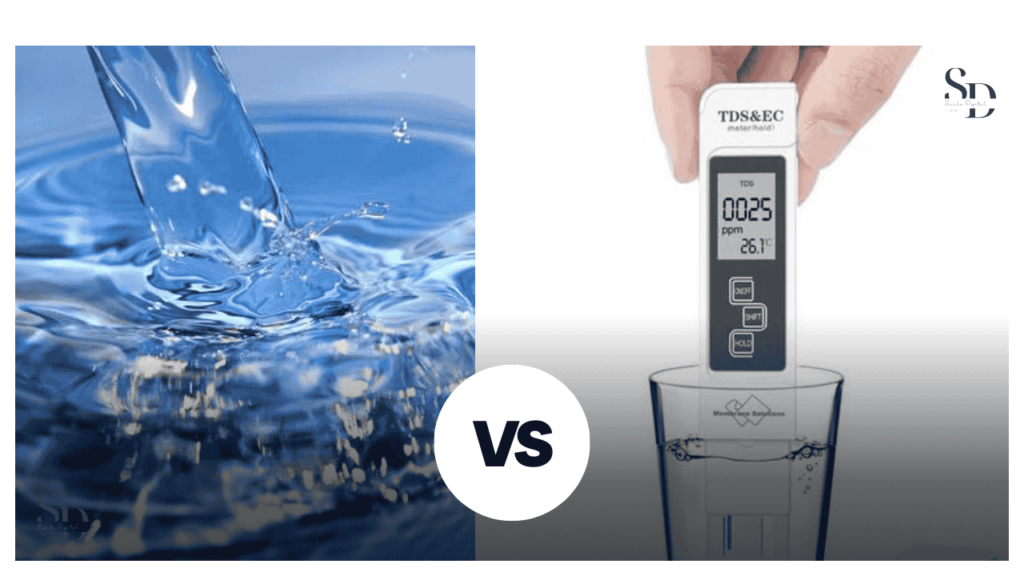
1. Visual Inspection Test
Purpose: To identify any visible impurities like floating debris, algae, suspended particles, or oil traces in water used for construction.
Procedure:
1. Collect a sample of water in a clean transparent glass or plastic container.
2. Hold the container against sunlight or any white background.
3. Carefully observe the water’s appearance.
Observation:
- Clear, colorless water – likely usable
- Greenish/yellow tint – presence of algae or organic matter
- Floating particles or oil film – unfit for concrete or curing use
Result Interpretation: Water must be visually clean and free of visible impurities. If particles are seen, water is not recommended without further treatment.
2. Odour Test
Purpose: To detect any foul, chemical, or unusual smell which may indicate contamination.
Procedure:
1. Take a small quantity of water in a clean container.
2. Smell the water directly.
Observation:
- No odour – safe to proceed
- Rotten egg, chemical, or sewage smell – could indicate organic or chemical contamination
Result Interpretation: Water should be odorless. Any smell may point to harmful substances and should be rejected or sent for lab testing.
3. Taste Test (Caution: Only done if water appears clean and safe)
Purpose: To identify any salty, bitter, or metallic taste, which may suggest high salt or metal content.
Procedure:
1. Take a tiny amount of water on your tongue.
2. Spit it out immediately after sensing the taste.
Observation:
- Neutral taste – likely usable
- Salty or metallic taste – high TDS or mineral content
- Bitter or chemical taste – possible chemical presence
Result Interpretation: Water should be bland or neutral in taste. Any abnormal taste indicates impurities and should not be used in concrete without testing.
4. pH Strip Test
Purpose: To quickly check if water is acidic, alkaline, or neutral — critical for cement hydration and setting.
Apparatus Required:
- pH indicator strips (range 0–14)
Procedure:
1. Dip a fresh pH strip into the water sample.
2. Wait a few seconds for the strip to change color.
3. Compare the strip’s color with the chart provided on the strip pack.
Observation:
- pH between 6.0 and 8.5 – acceptable
- Below 6 – acidic water (not recommended)
- Above 8.5 – alkaline water (can affect setting time)
Result Interpretation: Ideal pH range is 6.0 to 8.5 as per IS 456. Outside this range, lab testing is needed.
5. Soap Lather Test
Purpose: To detect presence of excessive hardness caused by calcium or magnesium salts.
Apparatus Required:
- Soap bar or liquid
- Transparent bottle or container
Procedure:
1. Fill a bottle with 100 ml of the water sample.
2. Add a few drops of liquid soap or rub a bar of soap inside the bottle.
3. Shake vigorously for 30 seconds.
Observation:
- Quick formation of foam/lather – water is soft and likely usable
- Minimal or no foam; white scum forms – hard water
Result Interpretation: Hard water reduces cement bonding. Excessive scum formation means water is hard and should be tested in lab before use.
6. Turbidity (Jar) Test
Purpose: To judge the amount of suspended particles visually when a turbidity meter is not available.
Procedure:
1. Collect a clear glass or plastic jar.
2. Pour water in it and place it over written text or any marked pattern.
3. Try to read the text through the water.
Observation:
- Clear visibility of text – low turbidity
- Blurred or blocked view – high turbidity due to suspended particles
Result Interpretation: Water must be clear enough to see through. If visibility is low, send for lab turbidity test.
7. TDS Meter Test (Total Dissolved Solids)
Purpose: To check the level of dissolved salts and minerals like chlorides and sulphates — a crucial test on-site.
Apparatus Required:
- Portable TDS Meter
Procedure:
1. Calibrate the meter if needed (some models are auto-calibrated).
2. Dip the meter’s probe into the water sample.
3. Wait 5–10 seconds until the reading stabilizes.
4. Note the reading in ppm (parts per million).
Observation:
- Below 2000 ppm – safe for concrete
- Above 2000 ppm – further lab testing required
- Above 3000 ppm – not suitable for concrete use
Result Interpretation: As per IS 456, water with TDS below 2000 ppm can generally be used for mixing concrete. Higher values may cause efflorescence, corrosion, and strength issues.
Laboratory Tests for Water
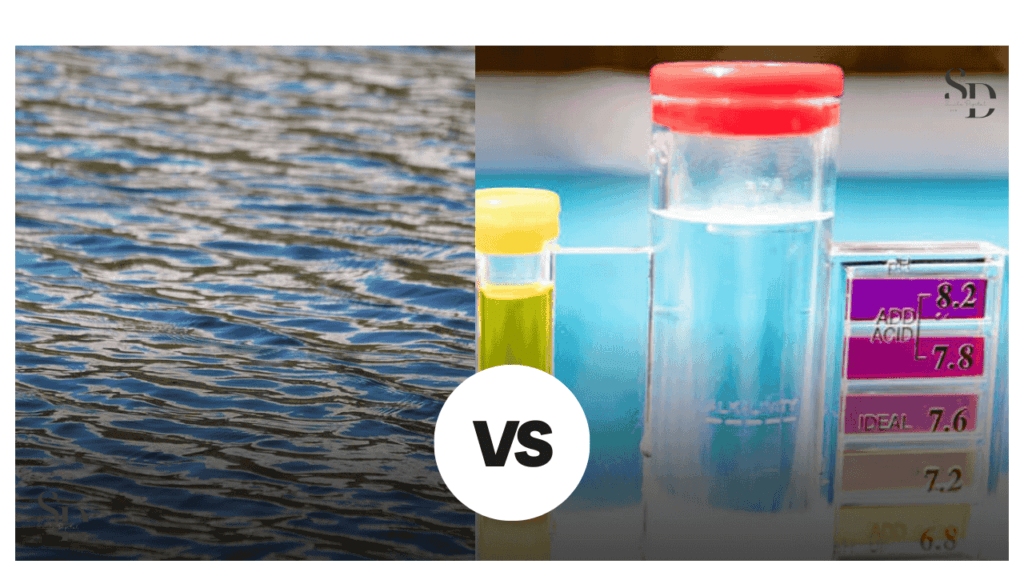
1. pH Value Test
Purpose: This test helps us understand if the water is acidic, neutral, or alkaline. Water that is too acidic or too alkaline affects the setting time of cement and can also reduce the strength of the concrete over time. pH influences the chemical reactions during the hydration of cement.
Apparatus Required:
- Digital pH meter
- Standard buffer solutions (pH 4, 7, and 9.2)
- Beakers
- Glass rod
- Distilled water
Test Procedure:
1. Calibration: Calibrate the digital pH meter with standard buffer solutions. This is crucial for accuracy. Usually, pH 7 is used first, then 4 and 9.2.
2. Sample Collection: Take the construction water in a clean beaker. Avoid air bubbles.
3. Measurement: Dip the electrode of the pH meter into the water sample. Wait until the reading stabilizes.
4. Reading: Note the displayed value. Repeat for 2-3 samples to confirm consistency.
5. Cleaning: Clean the electrode after each use to avoid cross-contamination.
Acceptable Limit (IS 456:2000): pH should not be less than 6.0 and not more than 8.5.
2. Total Dissolved Solids (TDS) Test
Purpose TDS tells us the total amount of inorganic salts and small amounts of organic matter dissolved in the water. High TDS can reduce bonding in concrete, impact setting time, and may introduce harmful ions like chlorides and sulphates.
Apparatus Required:
- Glass beaker
- TDS meter (portable)
- Weighing balance (for gravimetric method)
- Evaporating dish
- Hot air oven (for standard method)
- Filter paper
Standard Lab Method (Gravimetric):
1. Take 100 ml of water in a pre-weighed evaporating dish.
2. Evaporate the water on a water bath or hot plate.
3. Dry the dish in a hot air oven at 103–105°C.
4. Cool and weigh again.
5. The increase in weight is the TDS.
Formula : TDS (mg/L) = (Weight of residue / Volume of sample) × 1000
Acceptable Limit (IS 3025 Part 16): Should not exceed 2000 mg/L for construction water. Preferably below 500 mg/L.
3. Chloride Content Test
Purpose: Chlorides in water are dangerous for reinforced concrete. They cause rusting of steel, reduce the durability of structures, and promote corrosion under wet conditions.
Apparatus Required:
- Silver nitrate solution
- Potassium chromate indicator
- Burette, conical flask
- Pipette
- Distilled water
- Beaker
Test Procedure:
1. Take 100 ml of water sample in a conical flask.
2. Add 1 ml of potassium chromate indicator.
3. Titrate with standard silver nitrate solution until the brick-red color appears (due to silver chromate formation).
4. Note the volume of silver nitrate used.
Formula: Chloride content (mg/L) = (Volume of AgNO₃ × Normality × 35.5 × 1000) / Volume of sample
Acceptable Limits (as per IS 456:2000):
- 500 mg/L for plain concrete
- 200 mg/L for reinforced concrete
4. Sulphate Content Test
Purpose: Sulphates react with tricalcium aluminate in cement to form ettringite, which causes expansion, cracking, and damage in concrete. Especially critical in foundations and water-retaining structures.
Apparatus Required:
- Barium chloride solution
- Filter paper
- Measuring cylinders
- Hot plate
- Beaker
- Oven and desiccator
- Weighing balance
Test Procedure:
1. Take a known volume of filtered water sample.
2. Add barium chloride solution to precipitate sulphates as barium sulphate.
3. Heat the solution and let the precipitate settle.
4. Filter the precipitate using ashless filter paper.
5. Dry and weigh the residue.
Formula: Sulphate (mg/L) = (Weight of residue / Volume of sample) × 1000
Acceptable Limits (IS 456:2000): Not more than 400 mg/L.
5. Suspended Matter Test
Purpose: Suspended solids like silt, clay, fine sand, or organic particles reduce the clarity of water and negatively affect concrete strength by acting as impurities.
Apparatus Required:
- Whatman filter paper or equivalent
- Glass funnel
- Weighing balance
- Oven
- Beaker
Test Procedure:
1. Weigh a clean and dry filter paper (W1).
2. Pass a known volume of water (say 500 ml) through the filter paper using a funnel.
3. Dry the filter paper in an oven at 103°C for 1 hour.
4. Cool and weigh it again (W2).
Formula: Suspended solids (mg/L) = [(W2 – W1) / Volume of sample] × 1000
Acceptable Limits (as per IS 3025 Part 17):
- Should be below 2000 mg/L.
6. Alkalinity Test of Water
Purpose: Alkalinity tells us how much alkaline substances like bicarbonates, carbonates, and hydroxides are in the water. High alkalinity may affect the setting time of cement and cause efflorescence on the surface of concrete.
Apparatus Required:
- Burette
- Pipette
- Conical flask
- Phenolphthalein indicator
- Methyl orange indicator
- Standard sulfuric acid (H₂SO₄), N/50
- Distilled water
Test Procedure:
1. Take 100 ml of the water sample in a conical flask.
2. Add 2–3 drops of phenolphthalein.
If the solution turns pink, it indicates carbonate alkalinity.
3. Titrate with standard H₂SO₄ until the pink color disappears — Record volume (A).
4. Now, add 2–3 drops of methyl orange to the same solution.
It turns yellow to orange.
5. Continue titrating till the color changes to pinkish red — Record volume (B).
Calculation Formula: Total alkalinity (as CaCO₃ mg/L) = (B × Normality of acid × 50,000) / Volume of sample in mL
Acceptable Limit (IS 456:2000):
- Preferably less than 200 mg/L as CaCO₃.
7. Acidity Test of Water
Purpose: Acidity indicates the presence of free acids (like mineral acids or carbonic acid). Acidic water can corrode reinforcement bars and affect concrete bonding.
Apparatus Required:
- Burette, pipette, conical flask
- Methyl orange indicator
- Sodium hydroxide (NaOH) solution (standard N/50)
- Distilled water
Test Procedure:
1. Take 100 ml of the water sample in a conical flask.
2. Add 2–3 drops of methyl orange indicator (turns red in acidic medium).
3. Titrate with standard NaOH solution until the color shifts from red to yellow.
4. Note the volume of NaOH consumed.
Calculation Formula : Acidity (as CaCO₃ mg/L) = (Volume of NaOH × Normality × 50,000) / Volume of sample
Acceptable Limit:
- Should be as low as possible; ideally 0 mg/L for construction.
8. Organic Matter Test
Purpose: Organic matter like leaves, algae, and microbial waste in water can lead to formation of gases during concrete setting, which weakens the structure and may cause cracks.
Apparatus Required:
- Potassium permanganate (KMnO₄)
- Sulfuric acid (H₂SO₄)
- Water bath
- Burette
- Conical flask
- Pipette
- Sodium thiosulphate
- Starch solution
Test Procedure:
1. Take 100 ml of water sample.
2. Add fixed volume of KMnO₄ and H₂SO₄.
3. Heat the mixture for 10 minutes to oxidize organic matter.
4. After cooling, add excess sodium thiosulphate to neutralize the leftover KMnO₄.
5. Add starch indicator.
6. Titrate till blue color disappears.
Calculation: Organic matter is estimated in terms of Oxygen consumed (mg/L).
Acceptable Limit (IS 3025 Part 18): Should not exceed 200 mg/L.
9. Hardness Test of Water
Purpose: Hard water contains calcium and magnesium ions, which may react with cement and affect setting time and long-term durability of concrete.
Apparatus Required:
- EDTA solution (Ethylene Diamine Tetra Acetic Acid)
- Eriochrome Black T indicator
- Buffer solution (pH 10)
- Conical flask, burette, pipette
- Distilled water
Test Procedure:
1. Take 50 ml of water in a conical flask.
2. Add 2 ml of buffer solution.
3. Add a pinch of Eriochrome Black T — water turns wine red.
4. Titrate with EDTA solution until the color changes to blue.
5. Note the volume of EDTA used.
Calculation Formula: Hardness (as CaCO₃ mg/L) = (Volume of EDTA × 1000 × Molar mass of CaCO₃) / Volume of sample
Acceptable Limit: Preferably below 500 mg/L (total hardness).
10. Iron Content Test
Purpose: Iron in water may cause staining on concrete surfaces, interfere with hydration of cement, and may cause corrosion of steel reinforcement if in excess.
Apparatus Required:
- Spectrophotometer or color comparator
- Potassium persulfate
- Hydroxylamine hydrochloride
- 1,10-phenanthroline indicator
- Distilled water
- Beakers and flasks
Test Procedure:
1. Add reagents to the sample which form a colored complex with iron.
2. Wait for 10 minutes for full color development.
3. Compare color intensity in spectrophotometer or with a color comparator.
4. Measure absorbance and calculate concentration from standard calibration curve.
Acceptable Limit: Not more than 0.3 mg/L (as per IS standards for construction water).
11. Manganese Content Test
Purpose: Manganese is a metal that, if present in large quantities, can affect the color of concrete and may interfere with the hydration process. It can also stain tiles and surfaces when water evaporates.
Apparatus Required:
- Spectrophotometer or color comparator
- Potassium periodate solution
- Nitric acid
- Beakers and flasks
- Distilled water
Test Procedure:
1. Take a measured volume of water sample (usually 50–100 ml).
2. Add nitric acid to acidify the sample.
3. Add a few drops of potassium periodate solution.
4. The reaction forms a pink-violet colored compound if manganese is present.
5. After 10 minutes, measure the intensity of the color using a spectrophotometer or visually compare with a standard comparator.
Calculation: Using the absorbance reading and standard calibration chart, determine manganese concentration in mg/L.
Acceptable Limit (IS 10500, and relevant to IS 456): Preferably below 0.1 mg/L for concrete work.
12. Turbidity Test
Purpose: Turbidity is the measure of how clear or cloudy the water is. Suspended particles like silt, clay, and organic debris can increase turbidity. High turbidity may lead to weak bonding in concrete and mortar.
Apparatus Required:
- Nephelometer or Turbidity Meter
- Sample container (clean glass or plastic)
Test Procedure:
1. Collect a water sample in a clean container.
2. Insert it into the turbidity meter.
3. The meter shines light through the sample and measures how much light is scattered by the particles.
4. The result is displayed in NTU (Nephelometric Turbidity Units).
Observation:
- Clear water = low NTU
- Cloudy water = high NTU
Acceptable Limit: Should be less than 2 NTU for mixing concrete.
13. Electrical Conductivity (EC) Test
Purpose: Electrical conductivity indicates how many dissolved salts (ions) are present in water. Higher EC usually means high TDS, which can affect concrete durability and may cause corrosion in reinforcement.
Apparatus Required:
- EC meter / Conductivity meter
- Clean beaker
- Distilled water for calibration
Test Procedure:
1. Calibrate the EC meter using standard solution.
2. Dip the probe into the water sample.
3. Wait for a few seconds until the reading stabilizes.
4. Record the value in µS/cm (microsiemens per centimeter).
Observation:
- Low EC (below 2000 µS/cm) = good for concrete
- High EC (above 3000 µS/cm) = may contain excess salts
Acceptable Limit (as per IS 456 & IS 3025 Part 14): Preferably below 2000 µS/cm for concrete usage.
Some Important Facts
What is the Water Purification Process?
Water purification is the process of removing physical, chemical, and biological impurities from water to make it safe for drinking or industrial use.
Common Water Purification Process in India
In India, water purification is usually carried out by municipal bodies using a multi-stage process. Here’s a small step-by-step procedure commonly followed:
Step-by-Step Water Purification Process:
- Intake and Screening
- Water is taken from rivers, lakes, or underground sources.
- Large particles like leaves, branches, and plastic are removed using metal screens.
- Coagulation and Flocculation
- Chemicals like alum (aluminium sulfate) are added to water.
- These help tiny particles stick together to form bigger clumps called “flocs”.
- Sedimentation
- The heavy flocs settle down at the bottom in large tanks.
- This removes most of the suspended solids.
- Filtration
- The water is passed through filters made of sand, gravel, and charcoal.
- This removes smaller particles and some bacteria.
- Disinfection
- Chlorine, ozone, or UV light is used to kill any remaining bacteria, viruses, and germs.
- pH Adjustment (if needed)
- Lime or other chemicals may be added to maintain pH balance.
- Storage and Distribution
- Clean water is stored in overhead tanks and supplied to homes and industries.
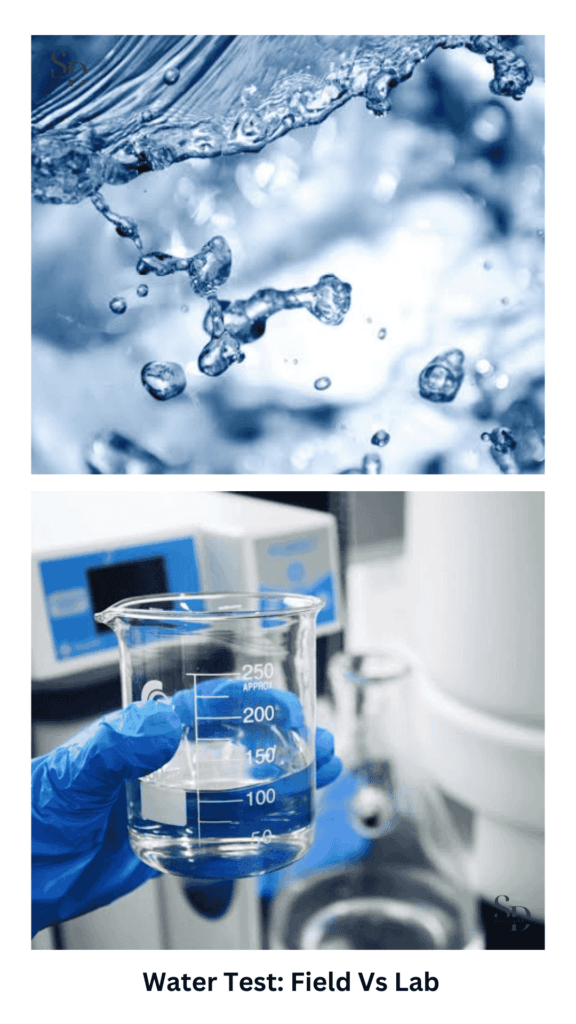
Types of Water Purification Methods
Here are different methods of purifying water:
1. Physical Methods
- Sedimentation – Settling of heavy particles.
- Filtration – Using filters to remove solids.
- Boiling – Kills bacteria and viruses (mostly domestic use).
2. Chemical Methods
- Chlorination – Adding chlorine to disinfect.
- Alum (for coagulation) – Helps remove suspended particles.
- Ozonation – Powerful oxidizing method for disinfection.
3. Biological Methods
- Slow Sand Filters – Useful for removing biological impurities in rural areas.
4. Advanced/Modern Methods
- Reverse Osmosis (RO) – Removes dissolved salts and heavy metals.
- UV Purification – Kills microbes using ultraviolet rays.
- Carbon Filtration – Removes bad taste, odor, and some chemicals.
- Electro-Dialysis – Used for desalination.
Books
- Water Quality & Treatment
- Water Quality Concepts, Sampling and Analyses – Yuncong Li, Kati Migliaccio
- Quality Assurance for Water Analysis
- Water and Wastewater Technology – Mark J. Hammer
IS Codes
- IS 10500:2012 – Drinking Water – Specification
- IS 3025 (Part 1 to Part 58) – Methods of Sampling and Testing of Water and Wastewater
- IS 456:2000 – Code of Practice for Plain and Reinforced Concrete
- IS 4984:2016 – Guidelines for Drinking Water Pipelines (HDPE)
- IS 11624:1986 – Guidelines for Drinking Water Quality
- IS 13428:2005 – Packaged Natural Mineral Water
- IS 14543:2004 – Packaged Drinking Water
Conclusion
Water is one of the most valuable natural resources on Earth, essential for human survival, agriculture, industrial use, and construction. But not all water is fit for all purposes. That’s why testing water before use—whether for drinking, construction, or environmental monitoring—is extremely important.
We test water to know its physical, chemical, and sometimes biological properties. Tests like pH, TDS, turbidity, and hardness help us understand whether water is safe and usable. In construction, even a small amount of impurity can reduce the strength of concrete. In drinking water, excess of metals or chemicals like iron, chloride, or manganese can be harmful to health.
Laboratory tests give us accurate results, while field tests are quick and useful for initial checking. Both are important depending on the use. IS Codes help us follow a standard procedure so that the test results are reliable and acceptable across India.
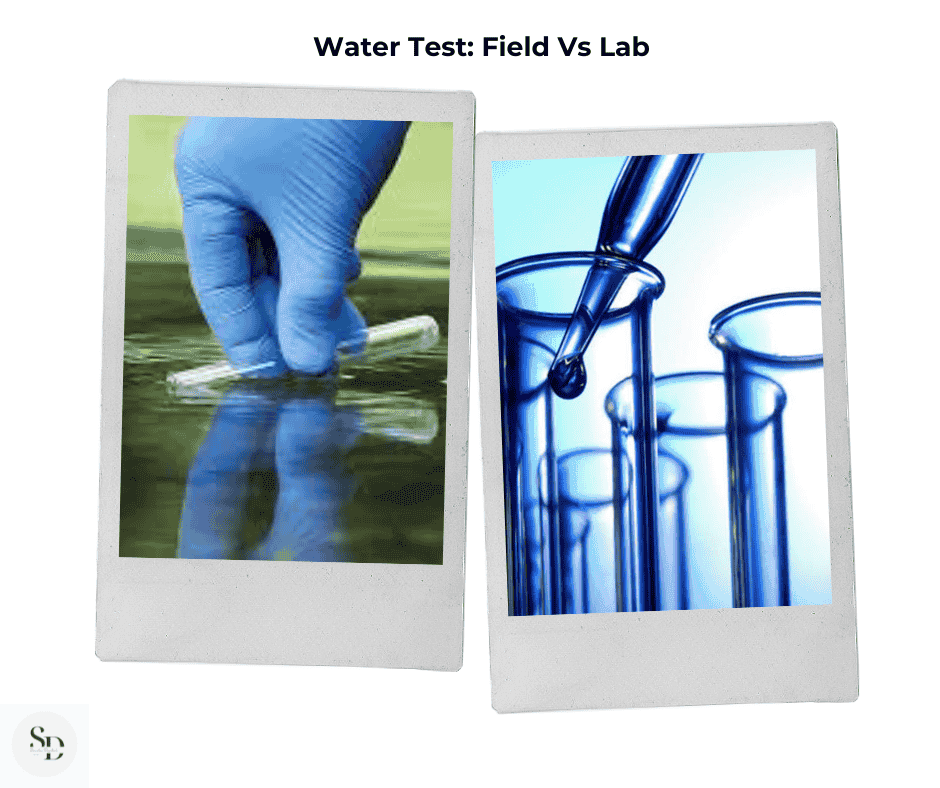
In summary, water testing is not just a formality; it is a necessity. Whether it’s a village drinking supply or a high-rise concrete structure, clean and tested water ensures safety, quality, and long-term durability. Understanding how and why we test water is a big step towards better infrastructure and healthier living.
Thank You Note
Thank you for taking the time to explore the complete guide on water testing. Your interest in understanding the tests, procedures, IS codes, and practical use reflects your commitment to quality and safety. Whether you are a student, professional, or field worker, this knowledge will surely add value to your work and decisions related to water use.
If you found this guide useful, feel free to share it with others in the construction industry. Stay tuned for more informative content on construction materials and testing methods.
Happy learning and building!
Frequently Asked Questions (FAQs)
What is turbidity in water?
How is water tested on-site (in field)?
What are IS Codes used for in water testing?
Is lab testing more accurate than field testing?
Can we use hard water in concrete?
What is TDS and what does it indicate?
Why is pH testing important in water?
Note for Readers
If you’d like to read this blog in your regional language or any other international language, simply click on the Google Translator option located in the bar at the top of the page. This feature allows you to select your preferred language and enjoy the content in a way that’s comfortable for you. We hope this makes your reading experience more enjoyable and accessible!
Disclaimer
The information provided here is for educational and general guidance purposes. Though every effort has been made to keep the content accurate and updated, users should refer to the latest official IS Codes and consult professionals for critical applications. The author holds no responsibility for direct or indirect loss arising from the use of this information.
For more exciting topics, explore our other articles here
- Concrete Test: Field vs Lab
- Wall Pop vs Putty
- Soil Test: Field vs Lab
- Steel Test: Field vs Lab
- Concrete: DT vs NDT
- Brick Test: Field vs Lab
- Coarse Aggregate Test: Field vs. Lab
- Sand Test : Field vs Lab
- Cement Test : Field Vs Lab
- PCC vs RCC
- One-Way Slab vs. Two-Way Slab
- Brick Masonry vs Stone Masonry
- Difference Between OPC and PPC Cement